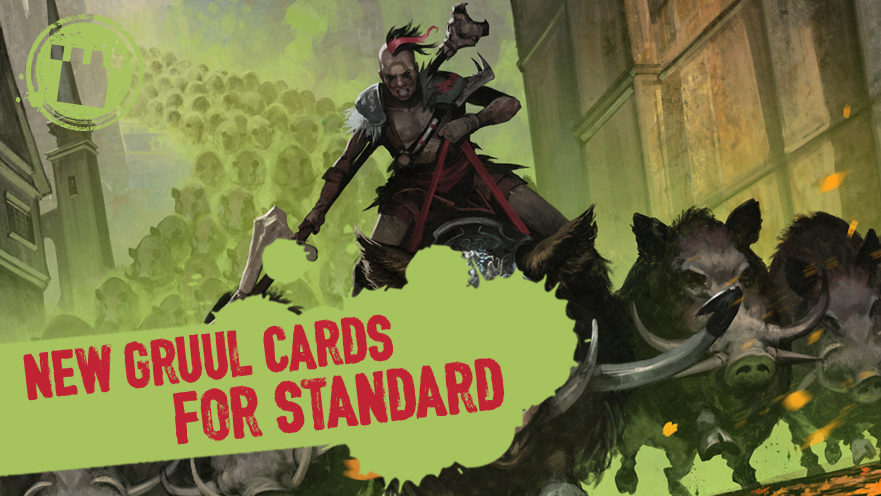Ravnica Allegiance throws us into the wild, brutal world of the Gruul Clans. With a brand new mechanic and even a planeswalker to evaluate, the set gives aggressive players a smorgasbord of exciting tricks and toys.
The old adage that it pays to play aggro at the beginning of a format would seem to bode well for red and green decks in these early weeks of a new Standard. But how can you get the most out of new aggro cards? Let us rampage through the Gruul cards of Ravnica Allegiance for some of their biggest and hardest hitters.
There’s A Riot Goin’ On
Gruul’s new mechanic is riot, an updated version of tribute that we saw in the Theros block. If a creature you control has riot, you choose for that creature to enter the battlefield with either a +1/+1 counter or haste. Flexible and dynamic, riot provides players with a choice every time you play a creature with the keyword.
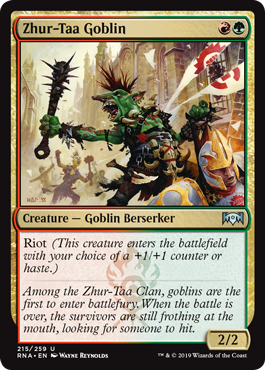
So, which choice is best? Well… most of the time, it should be haste. To illustrate, use this example. Imagine it’s Turn 2, and you’ve just resolved a Zhur-Taa Goblin. Let’s look at some numbers for cumulative damage output:
Turn 2 Damage
– With haste: 2
– With +1/+1: 0
Turn 3 Damage
– With haste: 4
– With +1/+1: 3
Turn 4 Damage
– With haste: 6
– With +1/+1: 6
So, it has taken three turns for a Zhur-Taa Goblin with that +1/+1 counter to equal the cumulative damage output it could provide had its controller given it haste. Of course, at that point, the +1/+1 will start over-performing its hasty counterpoint, but that’s also three turns that the opponent could remove it from the board.
When playing aggressively, prioritizing damage can be the difference between a victory and a defeat. This effect is only exaggerated on creatures with larger base power. A mighty Skarrgan Hellkite needs five turns to break even with a +1/+1 counter!

So, when might it be correct to opt for that counter instead of haste? That will usually depend on your opponent’s removal spells. Two of Gruul’s most exciting riot creatures give you the option to grow beyond some of Standard’s most common removal. Dropping a Gruul Spellbreaker as a 4/4 will dodge Deafening Clarion on the following turn, while Skarrgan Hellkite can enter as a 5/5, to the frustration of every player holding a Lava Coil in reserve. Always remember that a creature with riot enters the battlefield with its counter – your opponent cannot respond to it by casting instants to kill it before the counter gives the creature a boost. Learning how to correctly navigate the choices riot presents will be key to properly using Gruul cards.
Wild Fires
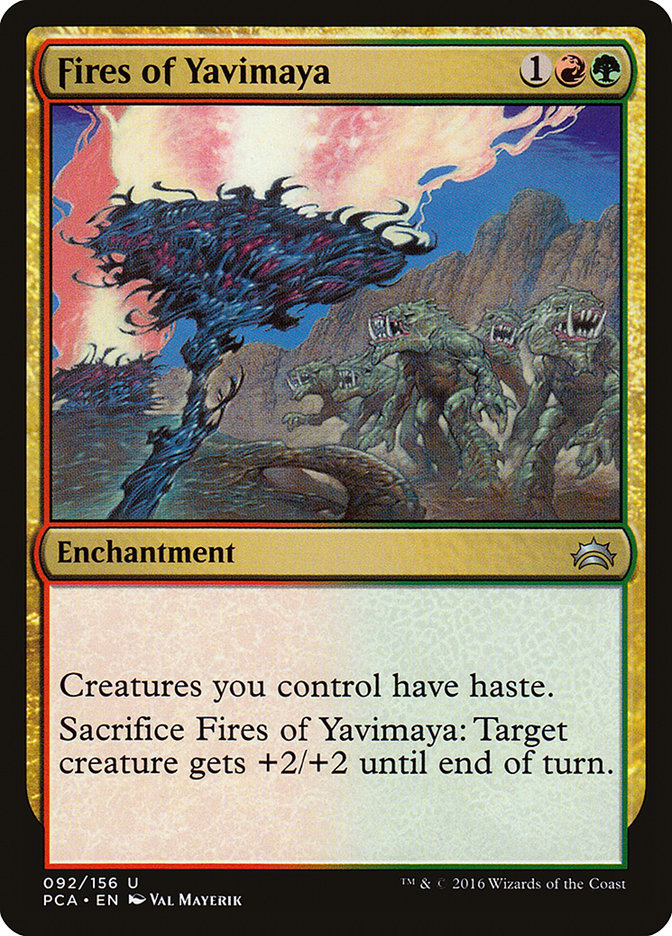
Let’s take a quick sojourn into Magic‘s past and talk about the Fires archetype. Way back in the halcyon days of Mercadian Masques and Invasion, a relatively innocuous little enchantment was changing the face of Standard play. Fires of Yavimaya was the linchpin of one of the strongest decks in the format. With a quick mana bump from a Birds of Paradise or Llanowar Elves, a Fires on Turn 2 would proceed to power out monster after monster, all rushing wildly at the opponent’s face with haste. Fast forward to 2019, and we still have Llanowar Elves, while Ravnica Allegiance gives us Rhythm of the Wild.
It’s hard to understate the power of giving all creatures haste. You know what’s worse than an early Ghalta? A Ghalta that immediately attacks. Nullhide Ferox, Ripjaw Raptor, Rekindling Phoenix… they all get much scarier when they can immediately slam into the red zone. What’s more, Rhythm of the Wild even lets you choose to make those creatures bigger. You know, for all those times that you really need Ghalta to be a 13/13.
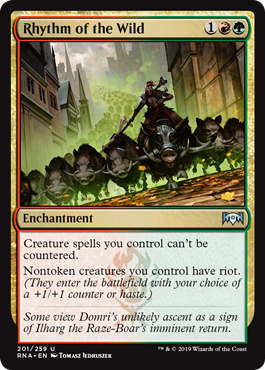
While the key clause of “nontoken creatures” prevents some of the shenanigans Fires of Yavimaya threw in our face years ago, Standard has access to far more powerful creatures than it ever did back in the early 2000s. And we haven’t even talked about how Rhythm makes all your creatures uncounterable! Teferi & Friends might have some problems when they can’t actually keep any creatures from entering play.
Rhythm of the Wild also allows you to have your riotous cake and attack with it too! If your creatures have multiple instances of riot, you can choose a different option for each one. Do you want to cast Rhythm, followed by a Gruul Spellbreaker? You get to choose between a monstrous 5/5 for three mana, or a 4/4 with trample, haste, and (temporary) hexproof (or, you know, a 3/3 with haste twice, for you Rocket-Powered Turbo Slugs out there). Be prepared for this combination to stomp all over your Limited decks, and very possibly some of your Constructed decks as well.
The Boy Is Back In Town
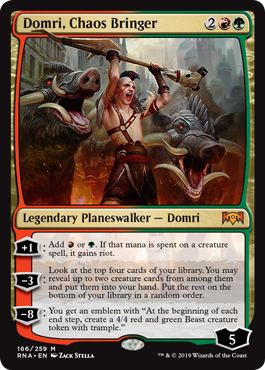
Domri, Chaos Bringer is here, and he means some serious aggro business. While he ironically has the highest mana cost of the planeswalkers in the set, his abilities allow for some extremely dedicated and determined attacking. Again, we see a non-creature card giving creatures riot, allowing for powerful and unexpected swings in tempo. Pairing up with creatures that already have riot will only add more force behind those punches. Llanowar Elves will allow Domri to get online early, ramping you into powerful haymakers before your opponent is ready to respond.
Domri‘s second ability is the most exciting for me, though. In a deck with enough creature density, you might be drawing two cards with each activation. That should keep you restocked with threats at a rate pretty much unseen in aggressive decks.
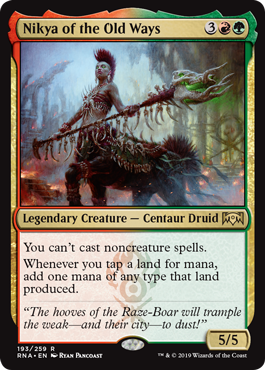
If you’re already committed to having a large number of creatures in your deck, Nikya of the Old Ways is just begging for inclusion. More mana will equal more creatures, and the onslaught could reach truly overwhelming proportions with the inclusion of Standard all-star Experimental Frenzy. I can imagine few things more satisfying for a Gruul player than flipping creature after creature off the top of their deck, all with a haste boost from Rhythm of the Wild, paying half the usual mana thanks to Nikya‘s influence. Eventually the Ravager Wurms show up, and it’ll all be over for your opponents.
So, as we prepare for Ravnica Allegiance to enter the format, consider what the Gruul Clans can offer you. Your opponents will be trying to draw dozens of cards with the Azorius, or grafting twenty extra eyes onto a poor lizard with the Simic. You know what might be more powerful than all of that? Setting the scheming aside, and embracing the primal joys of turning your creatures sideways on the turn you play them. Let the riot begin.

Simon is a Retail Sales Specialist at Mox Boarding House Seattle. He started playing Magic during Odyssey block, finding success on the Junior Super Series circuit and eventually playing at the 2004 US Nationals. After a multi-year break from the game, he was brought back with the reprinting of his favorite card, Lightning Bolt, in the 2010 Core Set. Simon is a loyal Red Deck Wins player and is always doing his best to win with Mountains in every Constructed format. He has a deep affection for the Magic storyline and will happily discuss the peculiarities of the Kamigawa block with you upon request.

